As researchers strive to create a more sustainable future for our energy grid, understanding the intricacies of how electrons move within small, natural systems has become a key focus. One particular area of interest lies in protein nanocrystals, where recent studies have shed light on electron behavior that challenges previous theories. Researchers from the Michigan State University-Department of Energy Plant Research Laboratory (PRL) have delved into the movement of electrons within crystal structures containing hemes, leading to intriguing discoveries that could have significant implications for energy-related applications.
In 2020, scientists in Dave Kramer’s lab at the PRL conducted experiments to observe electron flow within protein nanocrystals illuminated by a light source. These crystals contained heme molecules, known for their involvement in vital biological processes such as oxygen and electron transport. Surprisingly, researchers found that the rate at which electrons transitioned between heme molecules varied significantly with the crystal’s temperature. This unexpected temperature dependency challenged prevailing theories, which assumed a constant rate of electron transfer regardless of temperature fluctuations.
The observed electron movement within the protein nanocrystals resembled a person hopping from one rock to another while crossing a stream. By monitoring changes in heme colors—from red to pink—researchers could track the path of electrons within the crystal. What caught the scientists off guard was the pronounced effect of temperature on these color changes, surpassing expectations set by existing theoretical frameworks. To delve deeper into this phenomenon, computer simulations utilizing molecular dynamics were employed to simulate electron transfer dynamics. While the simulations aligned closely with experimental observations, discrepancies still persisted, hinting at unexplored factors influencing electron behavior.
The quest to unravel the mystery of electron movement in protein nanocrystals brought together researchers from the PRL and biochemistry Professor William Parson from the University of Washington School of Medicine. Parson’s prior work, grounded in the seminal theory of Rudolph Marcus, provided a critical foundation for interpreting the slow electron transfer rates observed in the crystal structures. Collaborations and insights from experts in the field continue to be instrumental in piecing together the puzzle of electron behavior within nanocrystals, shedding light on the intricate processes governing energy transfer.
The unresolved complexities surrounding electron movement in protein nanocrystals pose intriguing prospects for future research, particularly in the realm of energy applications like photosynthesis. By leveraging insights from this study, researchers aim to harness electron transfer pathways in nanocrystals to redirect energy towards sustainable energy production, such as biofuel generation. The potential of crystal structures and similar media to serve as conduits for efficient energy transfer opens up new avenues for advancing renewable energy technologies.
The enigmatic behavior of electrons within protein nanocrystals presents a compelling area of study with significant implications for energy research. By challenging established theories and leveraging cutting-edge simulations and collaborations, researchers are poised to unlock new insights into electron dynamics within natural systems, paving the way for innovative energy solutions in the future.


Leave a Reply